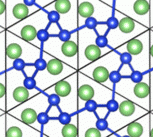
Submitted by Dr Nalin Patel on Mon, 15/09/2014 - 10:16
Researchers from the University of Cambridge and University College London have devised a new simulation technique which reliably predicts the structure and behaviour of different materials, in order to accelerate the development of next-generation batteries for a wide range of applications.
Using software to predict the characteristics of materials before they’re synthesised in order to guide and interpret experiments, the researchers successfully predicted the structures of a series of lithium silicides, an important step in understanding batteries made of silicon, and have also predicted new structures for a battery based on germanium. Details are published in the journal Physical Review B.
“It’s always exciting when we’re able to successfully predict something, but it’s especially gratifying to predict something that’s really useful,” said Dr Andrew Morris, Winton Advanced Research Fellow at the University’s Cavendish Laboratory, the paper’s lead author.
Details can also be found on the University Research website.

